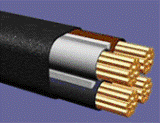Control (power) cable KVVG — work
 KVVG is one of the best selection control cables. The current-carrying wire of the wire is represented by a single-wire copper base, which allows operation under conditions of alternating voltage up to 600 volts and frequency up to 100 hertz. At constant voltage, the wire can withstand a current of up to 1000 volts, which is a very good indicator for a wire of this class.
KVVG is one of the best selection control cables. The current-carrying wire of the wire is represented by a single-wire copper base, which allows operation under conditions of alternating voltage up to 600 volts and frequency up to 100 hertz. At constant voltage, the wire can withstand a current of up to 1000 volts, which is a very good indicator for a wire of this class.
The reliable insulation made of polyvinyl chloride (PVC) plastic mixture makes it possible to use the cable for fixed contact with electrical appliances, equipment and when assembling clamps of electrical distributors.
 As for the temperature stability of the cable, the wire can be used in a labile ambient temperature, in the range of minus to plus 50 degrees. At the same time, the heating temperature of the wires during operation can reach 70 degrees above zero, which does not affect the operation and safety of the wire.
As for the temperature stability of the cable, the wire can be used in a labile ambient temperature, in the range of minus to plus 50 degrees. At the same time, the heating temperature of the wires during operation can reach 70 degrees above zero, which does not affect the operation and safety of the wire.
At an air and ambient temperature of 35 degrees, the air humidity can reach 98 percent, which will not affect the efficiency of the conductor.In order to fulfill all the above characteristics in the future, the installation of the cable must be carried out at positive temperatures with a construction length of at least 150 meters. Otherwise, the technical characteristics of the wire may change, but, as practice shows, not much.
When twisting the KVVG wire, cable yarn or paper cable is used. These materials give the wire a rounded shape. At the same time, in each vein, the veins have a different color, which makes it possible to distinguish them from the other veins that are in the vein.
The manufacturer of this wire indicates its service life: 15 years outdoors and 25 years in ducts, rooms and tunnels.
The work of KVVG is carried out in accordance with state GOST 26411 and must meet its requirements.
First, there must be a plan of normative, technical and design documentation for laying cables. Also, during installation, it is necessary to observe measures that prevent the spread of combustion during the group laying of the cable.
The standard of tensile stress that can be created during cable laying should not exceed 4 kgf per square millimeter.
It is also necessary to take into account the bending radius of the cable during installation. If the ambient temperature is above zero, then it can reach three cable diameters.
The number of cable cores varies from 4 to 37, and their cross section can be in the range of 0.75 to 6.0. Such a large selection allows the buyer to choose a suitable option that meets all his requirements.
According to its technical characteristics, the wire can be used in rooms, tunnels, in an aggressive environment and in the absence of mechanical influences on the cable. The only condition that must be observed when laying the cable underground is to provide protection in the places where the wire comes to the surface. Also, the cable can be laid on the surface, but, as already mentioned, in this case the total work time is significantly reduced.
The research carried out by the manufacturer of this cable shows that this power cable is not only one of the most reliable and efficient in the domestic market, but also very affordable for both companies and private buyers.
